#transitional justice
Text
Theories of The Philosophy of Peace
The philosophy of peace is a complex field that explores the nature of peace, its principles, and the conditions required to achieve it. Here are some prominent theories and perspectives within the philosophy of peace:
Pacifism: Pacifism is a foundational theory of peace, emphasizing non-violence and the rejection of war as a means of resolving conflicts. It includes various subcategories, such as absolute pacifism (opposition to all forms of violence) and conditional pacifism (accepting non-violent resistance but opposing armed conflict).
Just War Theory: This theory, rooted in ethical philosophy, provides a framework for determining when wars can be morally justifiable. It sets criteria for the initiation and conduct of wars and emphasizes proportionality and the protection of non-combatants.
Positive Peace: Positive peace goes beyond the absence of war and focuses on the presence of conditions that contribute to a just and sustainable peace. It considers socio-economic equity, social justice, human rights, and environmental sustainability as essential components of lasting peace.
Conflict Resolution Theories: These theories aim to resolve conflicts through non-violent means. They include negotiation, mediation, diplomacy, and alternative dispute resolution methods. The works of scholars like Johan Galtung and his "positive and negative peace" concept contribute to this field.
Cosmopolitanism: Cosmopolitanism promotes a global perspective that transcends national boundaries. It suggests that a sense of shared humanity can lead to a more peaceful world by emphasizing global citizenship and cooperation among nations.
Feminist Peace Theory: Feminist perspectives on peace challenge traditional notions of masculinity and warfare. They argue for the inclusion of women's voices in peace processes and highlight the links between gender equality, security, and peace.
Transitional Justice: This theory focuses on addressing the legacies of conflict and human rights abuses in post-conflict societies. It explores mechanisms for accountability, truth-telling, reconciliation, and reparations to establish a foundation for lasting peace.
Human Rights-Based Approaches: These approaches assert that peace and human rights are intertwined. They emphasize the protection of individual rights as a prerequisite for achieving and maintaining peace.
Gandhian Philosophy: Inspired by Mahatma Gandhi's principles of non-violence and civil disobedience, this philosophy advocates for peaceful resistance as a means to challenge injustice and oppressive regimes.
Global Governance: Global governance theories explore the role of international institutions, such as the United Nations, in promoting peace and stability at the global level. They propose mechanisms for collective decision-making and conflict resolution.
Conflict Transformation: This approach views conflicts as opportunities for positive change and transformation. It seeks to address the underlying causes of conflicts and create conditions for lasting peace by changing the dynamics between parties involved.
Ethical and Religious Perspectives: Many ethical and religious traditions offer insights into the philosophy of peace. These perspectives often emphasize values such as compassion, forgiveness, and the importance of community in achieving peace.
These are just a few of the theories and perspectives within the philosophy of peace. Each theory contributes to a deeper understanding of the nature of peace, the conditions necessary for its realization, and the ethical considerations involved in striving for a more peaceful world.
#philosophy#knowledge#learning#chatgpt#education#ethics#politics#Peace Philosophy#Pacifism#Just War Theory#Positive Peace#Conflict Resolution#Cosmopolitanism#Feminist Peace Theory#Transitional Justice#Human Rights#Gandhian Philosophy#Global Governance#Conflict Transformation#Ethical Perspectives#Religious Peace#Philosophy of Non-Violence
12 notes
·
View notes
Text
How does one assess the impact of transitional justice mechanisms in post-genocide societies?
Transitional justice mechanisms play a crucial role in post-genocide societies by addressing past atrocities, promoting accountability, and fostering reconciliation. Assessing the impact of these mechanisms is essential to understand their effectiveness in healing divided communities and preventing future conflicts. This article explores how one can assess the impact of transitional justice…

View On WordPress
#Accountability#compensation#democratic institutions#healing#historical memory#human rights#impact assessment#institutional reforms#justice#long-term impacts#post-genocide societies#prevention#prosecutions#reconciliation#reparations#socioeconomic reforms#specialized tribunals#structural reforms#transitional justice#truth#truth and reconciliation commissions#victim empowerment#victim participation
0 notes
Text
Dealing with the Past: Truth and Reconciliation Commissions in Eastern Europe
by Emancip8 Project

Addressing the legacies of conflict and human rights violations remain a significant challenge for many Eastern European countries. Truth and Reconciliation Commissions (TRCs) have been established in various global contexts to facilitate healing and promote justice, offering a valuable model for conflict-affected nations. This article will examine the potential role of TRCs in Eastern Europe, highlighting the importance of addressing the past to foster sustainable peace, and the challenges and opportunities associated with this process.
TRCs operate under the premise that revealing the truth about past human rights abuses is essential for reconciliation and social repair (Hayner, 2011). These commissions often conduct public hearings, collect testimonies, and produce comprehensive reports that document historical injustices. They may also recommend reparations, institutional reforms, and other measures to prevent the recurrence of violence (Bloomfield et al., 2003).
Eastern Europe has a complex history of armed conflicts, ethnic tensions, and human rights violations. The establishment of TRCs in the region could provide a crucial platform for addressing these issues, facilitating dialogue, and promoting understanding between divided communities (Minow, 1998). For example, the TRC in South Africa has been widely regarded as a successful model, contributing to a peaceful transition from apartheid to democracy (Gibson, 2004).
However, the implementation of TRCs in Eastern Europe is not without challenges. Establishing a TRC requires political will and commitment from all stakeholders, including governments, civil society, and affected communities (Lederach, 1997). The process must be sensitive to local cultural and historical contexts and should prioritize the needs and expectations of victims and survivors (Laplante & Theidon, 2007).
The role of international actors and the broader international community in supporting TRCs in Eastern Europe is also crucial. External assistance can provide necessary resources, technical expertise, and political support, but must be balanced with local ownership and agency (Brahm, 2007). Collaboration between local and international stakeholders can enhance the effectiveness and legitimacy of TRCs, ensuring that they are tailored to the specific needs and contexts of Eastern European countries.
In conclusion, TRCs hold significant potential as a tool for addressing the past, promoting reconciliation, and fostering sustainable peace in Eastern Europe. While challenges remain, the successful implementation of TRCs in the region will depend on strong local ownership, international support, and a commitment to truth, justice, and healing.
References:
Bloomfield, D., Barnes, T., & Huyse, L. (Eds.). (2003). Reconciliation after violent conflict: A handbook. Stockholm: International Institute for Democracy and Electoral Assistance.
Brahm, E. (2007). Uncovering the truth: Examining truth commission success and impact. International Studies Perspectives, 8(1), 16–35.
Gibson, J. L. (2004). Overcoming apartheid: Can truth reconcile a divided nation? The ANNALS of the American Academy of Political and Social Science, 601(1), 201–215.
Hayner, P. B. (2011). Unspeakable truths: Transitional justice and the challenge of truth commissions. Routledge.
Laplante, L. J., & Theidon, K. S. (2007). Truth with Consequences: Justice and reparations in post-truth commission Peru. Human Rights Quarterly, 29(1), 228–250.
Lederach, J. P. (1997). Building Peace: Sustainable Reconciliation in Divided Societies. Washington, D.C.: United States Institute of Peace Press.
Minow, M. (1998). Between vengeance and forgiveness: Facing history after genocide and mass violence.
Read more at Emancip8 Project.
#Truth and Reconciliation Commissions#Transitional justice#Emancip8 Project#Post-conflict reconciliation#Eastern Europe conflict resolution#Dealing with the past#Human rights violations Eastern Europe
0 notes
Text
The thing about public transportation is that it often operates at a loss or at least pretty thin profit margins no matter how much the ticket prices get raised. In a lot of places, service is bad, operator pays get cut while they're overworked, wait times are ridiculous, no one can get places in a timely manner most places, if you can get places at all, and a profit still isn't being turned
But the money and human suffering and indignity that public transport saves can't be quantified by profits from ticket sales. "Can people get places in your city easily to work, to school, for leisure, for socializing? How much money do you save when your workers get to their jobs on time? When people can access healthcare and government buildings easily? How much pain and suffering and human life do you save when people know they'll never be stranded in your city or town no matter the time, day, or how much pocket change they have?" these aren't questions answered by "it makes profit" and the necessity of infrastructure can't be measured by profit, you have to think long term, you have to look at benefits in more abstract ways, and all Business Models are deeply bad at that kind of planning. It isn't a mystery why a machine that exists to make profit right now isn't a machine that's good at making a robust system that focuses on long term benefits, fiscal or ethical. the fact that people are still struggling futilely to turn something with benefits that abstract and that vital into a dispenser of narrow, short-term return is fucking infuriating
Public transportation should be free and well-funded because a place where no one can get anywhere is a place no one can exist in public, and that's bad for the economy but it's also bad for human fucking dignity
7K notes
·
View notes
Photo

a villain’s journey
#scum villain's self saving system#svsss#luo binghe#shen qingqiu#shen yuan#finally read through the official localization.... it sent me right back to where i was when i first got into mxtx in 2019#back then my art was kind of in a transitional period so even though mxtx had me making art like crazy i didnt like much of it#and nowadays my mxtx tl on twt has all but vanished... but once again these books have rejuvenated me creatively#and i feel like ive progressed enough to do justice for how these stories make me feel. and properly scratch that creative itch#anyways. i hardly ever ramble in tags like this but im so emo about these books and i finally feel creative again#so i hope this is able to spread that joy...! sort of. ehe
3K notes
·
View notes
Text

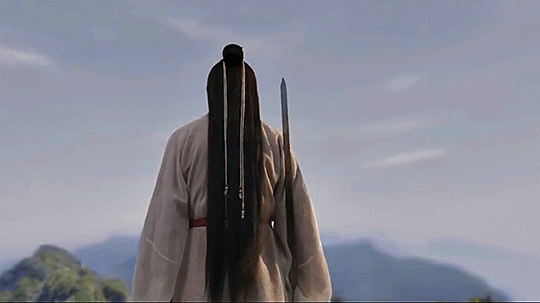

"All these years, he’s been alone. You are the only friend I’ve seen him with."
Li Lianhua & Fang Duobing | Mysterious Lotus Casebook (2023)
#I can't even do justice to the stunning cinematography in this show#li lianhua#mysterious lotus casebook#fang duobing#fanghua#mlc#my mlc gifs#lhl#the way the transition worked out on that last gifset.... proof of god tbh#or just proof that the filmmakers Knew What They Were Doing!!!!#ahpsdfoaihsidof#this show is so brilliant
226 notes
·
View notes
Text
Normalize updating laws and regulations that are no longer fit for purpose.
Normalize working with powerful enemies to find a solution where everybody wins.
Normalize mutual compromise.
Normalize collaboration over opposition.
Normalize civil discourse on divisive issues.
Normalize good faith and the principle of charity.
Normalize discussion of specific social, political, and economic issues.
Normalize advocacy for specific and implementable policy reforms to to tackle said issues.
Normalize imperfect solutions.
Normalize civic engagement.
Normalize public sector action.
Normalize incremental success.
Normalize improving society instead of destroying and rebuilding it from the ground up.
NORMALIZE PROGRESS!!!
#solarpunk#hopepunk#politics#political discourse#public policy#civic engagement#civic duty#georgism#transit#urban planning#accessibility#disability justice#disabled#healthy politics#policymakers#social justice#societal improvement#retain hope#societal progress#climate change#climate action#advocacy#trains#political activist#political action#activism#hanlon's razor#good regulations work#good faith arguments#good faith
227 notes
·
View notes
Text
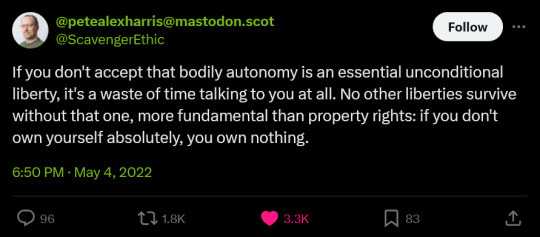
#queer#lgbtq community#lgbt pride#nonbinary#lesbian#abortion#abortion bans#reproductive freedom#sapphic#reproductive rights#reproductive justice#abortion rights#transition#trans joy#transgender#gay girls#dysphoria#trans women#anarchism#antifascism#anticapitalism#anarchy#anarchocommunism#socialism#lgbtqia#lgbtq#nonbinary lesbian
70 notes
·
View notes
Text
"DIGGER" HARKNESS/CAPTAIN BOOMERANG from SUICIDE SQUAD: KILL THE JUSTICE LEAGUE

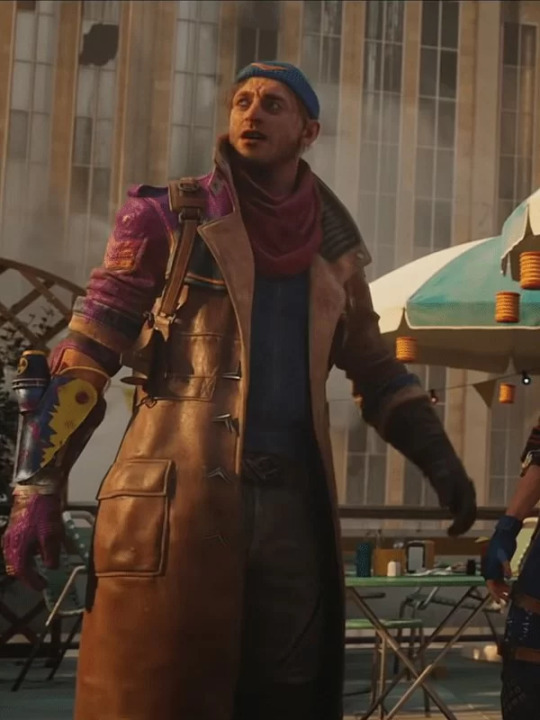
JUSTIFICATION:
"Throughout the game he gets repeatedly dunked on for propping up his self-image with self-aggrandising behaviour and trying to look cooler, to the point of one dialogue literally saying that (according to king shark) he smells of shame, self-loathing, fear, and body odour. (the BO is machismo, according to Boomerang)
Then, during the course of the game, the team gets thrown into another universe much like their own except the alien invasion was not fought off. The only other human there actually mentions a "Lady Boomerang", questioning why Captain Boomerang is dressed as her, and speaking of her VERY fondly.
This is like. One universe over. With a female Captain Boomerang who apparently dressed like the male one and was pleasant enough to be remembered fondly (which the male one...hes a dick and i love him for it okay). also Lady Boomerang when Captain is gender neutral sounds a lot to me like "trans woman just figured it out and is very excited"
tldr instead of "alcohol and misbehaviour" he should try estrogen about his problems" - Anonymous
Reminder: Submissions are always open! Submit here!
#could transition have saved her#captain boomerang#digger harkness#george digger harkness#suicide squad kill the justice league#suicide squad#dc comics#transgender#trans hc#anonymous submission
64 notes
·
View notes
Text
you guys ever heard the Dahlia to Lamiroir transition from the 20th anniversary concert? it drives me a bit insane.
#i believe? this is the first time they played dahlia's theme in their concert? anyway the transition is so smooth you guys. it's so smooth#music#dahlia hawthorne#thalassa gramarye#lamiroir#ace attorney trials and tribulations#ace attorney apollo justice#everyone listen to it. it's so good.
121 notes
·
View notes
Text

my transitioning goals
#ace attorney#apollo justice#aa4#aceattorney#hobo phoenix#hobo phoenix wright#beanix#transition goals#transmasc#transaceattorney#transmale#transmemes#transgender#trans#trans man#trans joy
60 notes
·
View notes
Text
By: Anonymous
Published: Oct 16, 2023
When my first son claimed he was trans, I eagerly ‘affirmed’ him. When his three-year-old brother decided he wanted to be trans, too, I realized I’d made a terrible mistake.
I was a social-justice organizer and facilitator before social justice took over the progressive world. I was at the nascent movement’s forefront, introducing the concept of intersectionality to organizations and asking people to share their pronouns.
My friends and I felt like we were the cool kids, on the vanguard of the revolutionary wave that would change the world. We were going to achieve what people in that milieu call “collective liberation.”
Within this context, I came out as a lesbian and identified as queer. I also fell in love, entered a committed relationship, and gave birth to a son. Two years later, my spouse gave birth to our second son.
Having children and experiencing the love and devotion I felt toward them, was a game changer for me. I began to experience internal tensions. My thinking was split between what I felt instinctively as a mother; and what I “should” be feeling and doing as a white anti-racist social-justice parent.
Because I’d felt victimized by my parents’ rejection of my sexuality, I wanted to make sure to honor my own children’s “authentic” selves. In particular, I was primed to look for any clues that might suggest they could be transgender.
My spouse and I raised our sons with gender-neutral clothes, toys, and language. While we used he/him pronouns, and others called them boys, we did not call them boys, or even tell them that they were boys.
In our everyday reading of books or descriptions of people in our lives, we did not say “man” or “woman”; we said “people.” We thought we were doing the right thing, both for them and for the world.
Even when our first son was still young, he already struck us as different from other boys—being both extremely gifted and unusually sensitive. By age three or so, he started to orient more toward the females in his life than the males. “I like the mamas,” he would say.
We started to attribute some of this difference to the possibility that he was transgender. Instead of orienting him toward the reality of his biological sex by telling him he was a boy, we wanted him to tell us if he felt he was a boy or a girl. As true believers, we thought that we should “follow his lead” to determine his true identity.
At the same time, I was taking a deep dive into the field of attachment and child development. This made me understand that attachment is hierarchical; and that parents, not children, are meant to be in the lead. This obviously conflicted with my insistence on letting my child decide his gender. Sadly, it was the latter impulse that won the day.
At around age four, my son began to ask me if he was a boy or a girl. I told him he could choose. I didn’t use those words—I imagined that I was taking a more sophisticated approach. I told him, “When babies are born with a penis, they are called boys, and when babies are born with a vagina, they are called girls. But some babies who are born with a penis can be girls, and some babies born with a vagina can be boys. It all depends on what you feel deep inside.”
He continued to ask me what he was, and I continued to repeat these lines. I’d resolved my inner conflict by “leading” my son with this framework. Or so I told myself.
His question, and my response to it, would come back to haunt me. In fact, I remain haunted to this day. To the extent I was “leading” my son anywhere, it was down a path of lies—an on-ramp to psychological damage and irreversible medical interventions. All in the name of love, acceptance, and liberation.
About six months later, he told my spouse that he was a girl and wanted to be called “sister” and “she/her.” I received a text message about this at work. On the way home that night, I resolved to put all my own feelings away and support my transgender child. And that is what I did.
We told him he could be a girl. He jumped up and down on the bed, happily saying, “I’m a girl, I’m a girl!” We—not our son—initiated changing his name. We socially transitioned him and enforced this transition with his younger brother, who was then only two years old and could barely pronounce his older brother’s real name.
When I look back at this, it is almost too much to write about. How could a mother do this to her child? To her children?
Once we made this decision, we received resounding praise and affirmation from most of our peers. One of my friends, who’d also socially transitioned her young child, assured me that this was a healthy, neutral way to allow children to “explore” their gender identity before puberty, when decisions would have to be made about puberty blockers and hormones.
We sought out support groups for parents of transgender children, so that we could find out if we’d done the “right thing.” It hadn’t escaped my notice that our son hadn’t exhibited any signs of actual gender dysphoria. Was he actually transgender?
At these support groups, we were told, again, what good parents we were. We were also told that kids on the autism spectrum (which our son likely is) are gender savants who simply know they are transgender earlier than other kids.
At one of the support groups we attended, we were also told that transgender identity takes a few years to develop in children. The gender therapist running things told us that during this period, it’s important to protect the child’s transgender self-conception—which meant eliminating all contact with family or friends who didn’t support the idea that our son was a girl. I believed her.
Looking back, I now see her comments in a shockingly different light: this was part of an intentional process of concretizing transgender identity in children who are much too young to know themselves in any definitive way. (One set of parents attending the group had a child who was just three years old.) When identity is “affirmed” in this manner, children will grow up believing they are actually the opposite sex.
The therapist endorsed the same approach that many adolescents use on their parents, who are urged to write letters to grandparents, aunts, and uncles to announce the child’s transgender identity. In these letters, the conditions of continued social engagement are made clear: Recipients must use the new name and new pronouns, and embrace the new identity, or they will be denied contact with the child.
After about a year of social transition for our older son, our younger son, who was by now only three years old, began to say he was a girl, too. This came as a complete shock to us. None of the things that made our older son “different” applied to our younger son. He was more of a stereotypical boy and didn’t show the same affinity for the feminine side of things that his older brother did.
The urge for “sameness” is a primal attachment drive in many family members. We felt that our younger son’s assertion of being a girl likely reflected his desire to be like his older sibling, in order to feel connected to him.
His claim to be a girl became more insistent when both brothers went to school part-time, because their program included pronoun sharing. Why could the older sibling be a “she” when the younger sibling couldn’t? Our younger son became more insistent, and we became more distressed.
We made an appointment to see the gender therapist whom we’d met at the support group. We truly believed that she would be able to help us sort out who, if anyone, was actually transgender.
To our shock, the therapist immediately began referring to our younger son as “she,” stating that whatever pronouns a young child wants to use are the pronouns that must be used.
She patronizingly assured us that it might take us more time to adjust, since parents have a hard time with this sort of thing. She added that it was transphobic to believe there was anything wrong with our younger son wanting to be like his older transgender sibling.
When I pushed back and asserted that I wasn’t yet convinced our younger son was in fact transgender, she told me that if I failed to change his pronouns and honor his newly announced identity, he could develop an attachment disorder.
We were unconvinced. But, again, we wanted to do what was right for our son and for the world. We decided to tell him he could be a girl. And that night at dinner, we told him that we would call him “she/her.”
Right after dinner, I went to play an imaginary game with him, and I wanted to be affirming. So I put a big, warm smile on my face and said, “Hi, my girl!”
At this, my younger son stopped, looked at me, and said, “No, mama. Don’t call me that.” His reaction pierced me to my core. I didn’t turn back after that.
For the next two years, my partner and I dug deeper, agonized, and then continued digging again. Everything we thought we knew or believed that had led us to socially transition our older son began to unravel.
I continued to study the attachment-based developmental approach to parenting and learned more about autism and hypersensitivity. We decided not to socially transition our younger son. Not only was he not transgender, we now realized, but our older son probably wasn’t either.
He was just a highly sensitive, likely autistic boy who saw a girl identity as a form of psychic protection. It also provided him a way of attaching to me through sameness.
My spouse and I decided that since we’d been the ones who’d led him down this path, we were the ones who needed to lead him off of it.
A year ago, just before our older son’s eighth birthday, we did just that. And while the initial change was hard—incredibly hard—the strongest emotion exhibited by our son turned out to be relief.
In the days following my first conversation with him about going back to his birth name and pronouns, during which I told him that males cannot be females and that we were wrong to tell him he could choose to be a girl, he got very mad at me, then sad. Then, the next day, I felt my son rest. I felt him release a burden, an adult burden that he, as a child, was never meant to carry.
Since that time, we’ve all been healing. My son is now happy and thriving. We’ve watched him come to a deeper peace with himself as a boy.
Our younger son is also thriving. Once his older brother became his older brother again, he happily, and almost immediately, settled into his identity as a boy.
I feel like someone who’s escaped a cult—a cult whose belief system is supported by our mainstream culture, the Internet, and even the state.
I fear for the future—the future of sensitive, feminine, socially awkward boys. I fear what the world will tell them about who they are.
But no matter what the future holds, I will never ever stop fighting to protect my sons. I am no longer a true believer.
#gender ideology#queer theory#genderwang#gender cult#social transition#autism#social justice#critical social justice#affirmation model#gender affirming#gender affirmation#trans identity#gender identity#child psychology#religion is a mental illness
116 notes
·
View notes
Text
Solarpunk Sunday Suggestion:
Ride on public transport
#solarpunk#hopepunk#environmentalism#social justice#optimism#cottagepunk#climate justice#community#bright future#trams#buses#trains#public transit#urban planning#fifteen minute cities#green#solarpunksundays
83 notes
·
View notes
Text
Adventures of Wally & The Gang (plus their Caretaker)
Keep A Level Head
Warnings: None. Humor. Just more silly antics. Inspired by the anime “ Aggretsuko”.
Word Count: 834
Brief Description: The Welcome Home cast is alive, living alongside humans. You have been contracted as their Caretaker. Our dear Caretaker has been running around all day, working hard. On top of your daily administrative work, you also have to babysit tend to the colorful ensemble of actors, plus all the other studio employees, who can’t seem to do things on their own.
[Not sure if this constitutes a WH!Muppet AU scenario?? Not sure how to tag it haha]
“Care! Hey, hey! Care--?! Hey! Caretaker! Heeeeeeeeeey!” Julie wails, following behind as you try to ignore her and focus on the task at hand.
No matter how many times you try to address the blonde, she pulls you away from what needs to be done, to what she wants to do. It’s become a bit of an irritating habit, although you’re convinced it’s her hobby, to distract you from your job so you can entertain her grabs for attention.
“Not now Julie, I have a lot of work to do, but I promise I’ll do whatever it is you’re wanting once I’ve got more time—”
“No, I need you now. The new dress I had ordered still hasn’t arrived and I—”
You drone out her increasing insistence, beginning to pick up the pace as you swerved through the crowd of studio employees and other puppets. Unfortunately, the moment the others sight you, the choir of:
“Hey Care—”
“--need you here—”
“Can you fix—”
“Get me some—”
You stop in your tracks, feeling Julie bump into you from behind. With your binder tucked close to your chest, your hands tighten around it. The overwhelming demands from the maintenance team, stagehands, cameramen, and puppets made you fume. It was obvious from your face how feelings of annoyance had now turned into full-blown anger. You tried steadying your breath, feeling the heat prickle at your cheeks, and reminding yourself to remain professional, you need this job, it pays the bills… it pays the bills…it pays the bills….
“Hold on!” You boom, causing the voices to settle. You stand your ground, steeling yourself as you take a breath. “I am extremely busy right now—” You strain, each word slow, with brows furrowed and jaw tight. “Sooo-- I’d appreciate it if you all stop pestering me for a moment, because if I hear one more per—”
“Hey, Care?” Barnaby interjects, poking his head out of the restroom door.
Your mouth shuts, head snapping around to look at him. “What?!”
“I clogged the toilet,” Barnaby responds monotonously, thumb pointing toward inside the restroom, as water slowly began trickling its way outside.
The grip around your binder tightens even more to the point you felt like you could have ripped it in half. Your eyes narrow into a glare, tight lips twitching up into a menacing grin.
“So uh… could you fix it?” Barnaby probes, moving away from the slow leak of water pooling around his feet.
“Please excuse me for a moment…” You seethe, quickly and silently moving your way toward one of the audio control rooms, knowing the padded walls would shield your outbursts. Upon arrival, you slammed the binder down onto the script stand, causing it to wobble and tilt over.
That was the last straw.
You bring your arms up, flailing them around as you release your rage. “What the actual [redacted]?! I just need to do one [redacted] thing! One thing! But nooooooo--! I can’t catch a [redacted] break around here! And why the [redacted] would Barnaby clog the toilet?! PUPPETS DON’T EVEN NEED TO USE THE [redacted] TOILET?!”
You heaved, palming your forehead for a second before sliding your hand over your eyes. You took a few deep breaths to soothe yourself until you heard an audible click and the sound designer over the two-way speaker.
“You, uh, okay in there?”
You drop your hand down to your mouth, eyes darting open to see not only the sound designer but a few of the puppets and two other employees who followed you to your location, staring at you from behind the glass.
You stared back.
Julie had arched a brow, crossing her arms over her chest in disapproval.
Wally’s half-lidded, unwavering, eyes peered at you. “Those are some naughty words there...” He commented, his voice crackling a bit through the speaker. Though, reading his expression you could tell he was a bit amused.
“Yes dear, you really should watch your language.” Poppy chimes, as everyone else in the sound room nods in agreement.
Standing there for a moment longer, you finally gave up. Picking up your binder and setting the script stand back up in place, you walk through the door into the sound room, staying silent as Barnaby stepped toward you with a plunger in hand.
“I found this if it’ll help with the toilet—”
You didn’t say anything as you walked past him, only extending a hand, and swiping the plunger from his grasp. You moved on through the exit.
[BONUS]
Barnaby and Wally both stood outside the restroom door, peering in and watching as you muttered curses under your breath and violently plunged the toilet to unclog whatever ungodly thing Barnaby stuffed in there.
Wally: “So, uh, Barnaby?”
Barnaby: “Yeah lil’ buddy?”
Wally: “What did you put in there?”
Barnaby: “Just a bunch of leftover doughnuts from the spread table.”
Wally: “…Why?”
Barnaby, shrugging: “Wanted to see what would happen…”
[For scientific inquiry]
#wally darling x reader#wally darling fanfic#wally darling fanfiction#welcome home fanfic#welcome home fanfiction#marsfics#marsfic#Adventures of Wally & The Gang (plus their Caretaker)#Adventures of Wally & The Gang (plus their Caretaker) series#[lmao so far ive tried to incorporate a lot more of the WH cast]#[definitely wanna do more of just Caretaker and Wally shenanigans]#[but barnaby is such a goober]#[okay okay im gonna explore more about the cast's personalities so i can write more from their narrative vs just Caretaker's narrative]#[tbh i might slowly transition to script based writing like i used to do in film... but i wanna give the characters justice]#[not make them so one dimensional...]#welcome home puppet show#welcome home puppet show fanfic#welcome home off script
125 notes
·
View notes
Text
Miles:Should i.....Is it the right time to tell Tim i love him?
Percy:Yeah!!!
Jason,simultaneously:Nah
Percy:*Slaps his chest*Ignore him,he's Batgirlless
Miles:I mean i don't know,Jason and i call eachother brothers so wouldn't it be weird?
Jason:I only think it's weird cause Tim a dweeb and you can do better
Percy:*Punches his shoulder*Tim's perfect for you and he's told me he thinks you're perfect in general
Miles,grinning goofily:.....He thinks of me in general?
Jason:Probably weird shi-
Percy:*Kicks him backwards in the crotch*Listen,you guys have no subtlely-Just put us out of our misery and we can go to Dairy Super together
Miles:Yeah......YEAH!!!!!I SHOULD JUST DIVE IN
Jason,kneeling over in pain and wheezing:MY DICK AND NO BALLS!!!!!!!
@refrigeratedboombursts @theautisticcentre
#go to dess' for more timiles btw👆🏼#the anomalies#miles morales#percy jackson#jason todd#tim drake#timiles#transmascfem miles morales#transfem percy jackson#persephone jackson#trans jason todd#t4t timiles#black percy#latino percy#afrolatino jason supremacy#autistic miles#autistic percy jackson#autistic jason todd#autistic tim drake#atsv#spiderman#pjo#hoo#batfam#utrh#young justice#team mom percy jackson#summerposting#for those of y'all unaware transmascs don't get balls even post transition#💌
30 notes
·
View notes
Note
PokéPollo and KlavierMon give me life!
Do you have anything else to share about them? Maybe there daily routine, fun things that have happened to them or how they met in this AU.
Ace Pokémon for the soul XD
hehe thank you for liking the au !!! an interesting little tidbit is that some pokemon they have on their teams have actually been with them since childhood! for example lucario's been with the gramarye family for A While now:

(yes they babyproofed him)
and klavier used to be extremely shy as a kid, so chatot was given to him to help voice out thoughts he couldn't say on his own :P
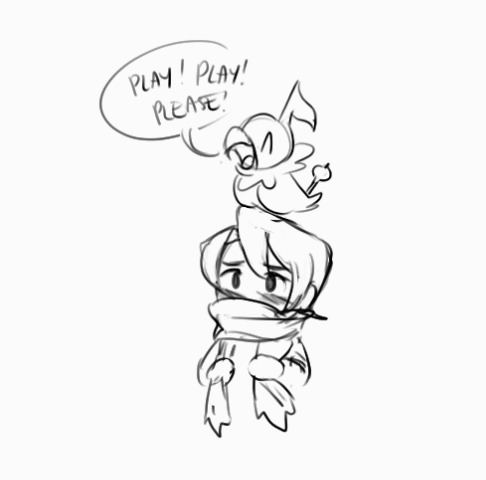
as for like. first meetings? idk about that, but here's what happened one hour after meeting each other 🥴
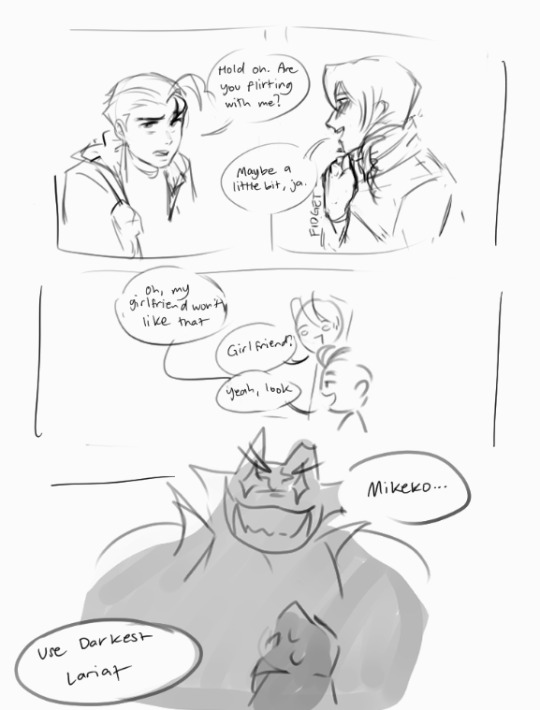
#klapollo#klavier gavin#apollo justice#trucy wright#ace attorney#pokemon#.png#ask#Anonymous#apollo's drawn pre-transition and pre-realization here lol. just so you know#hence the ponytail#ALSO THAT MIKEKO USE DARKEST LARIAT THING HAS BEEN IN MY HEAD FOR YEARS NOW#AND THIS ASK FINALLY PUSHED ME TO DRAW IT SO#THANK YOU ANON !!!!!
170 notes
·
View notes